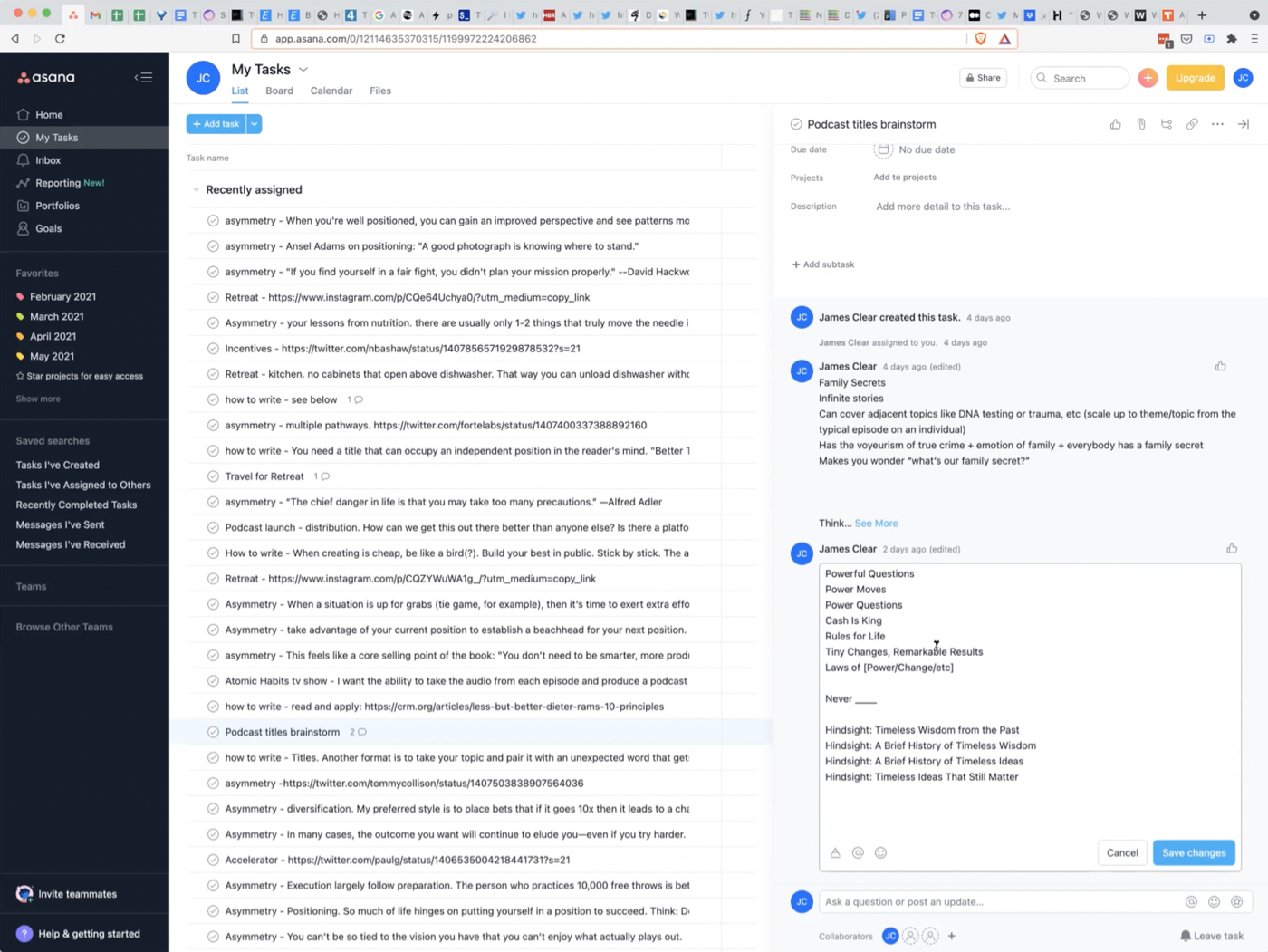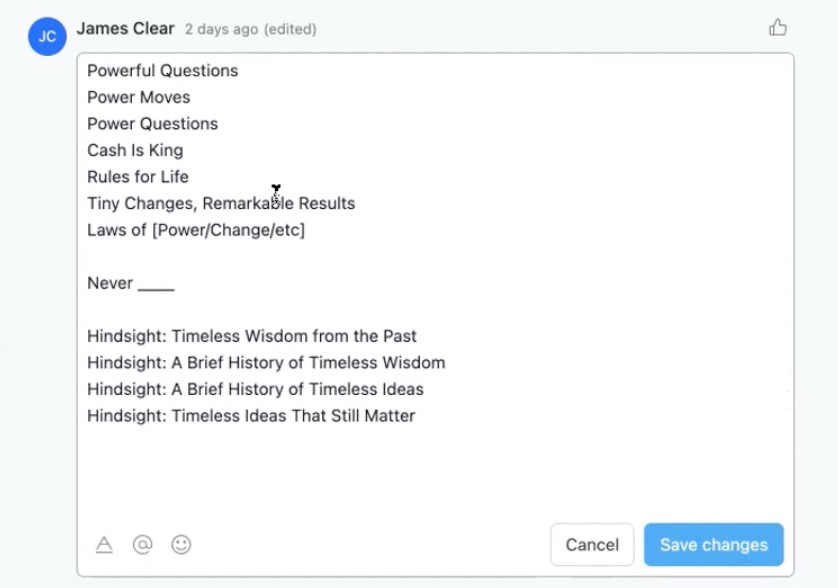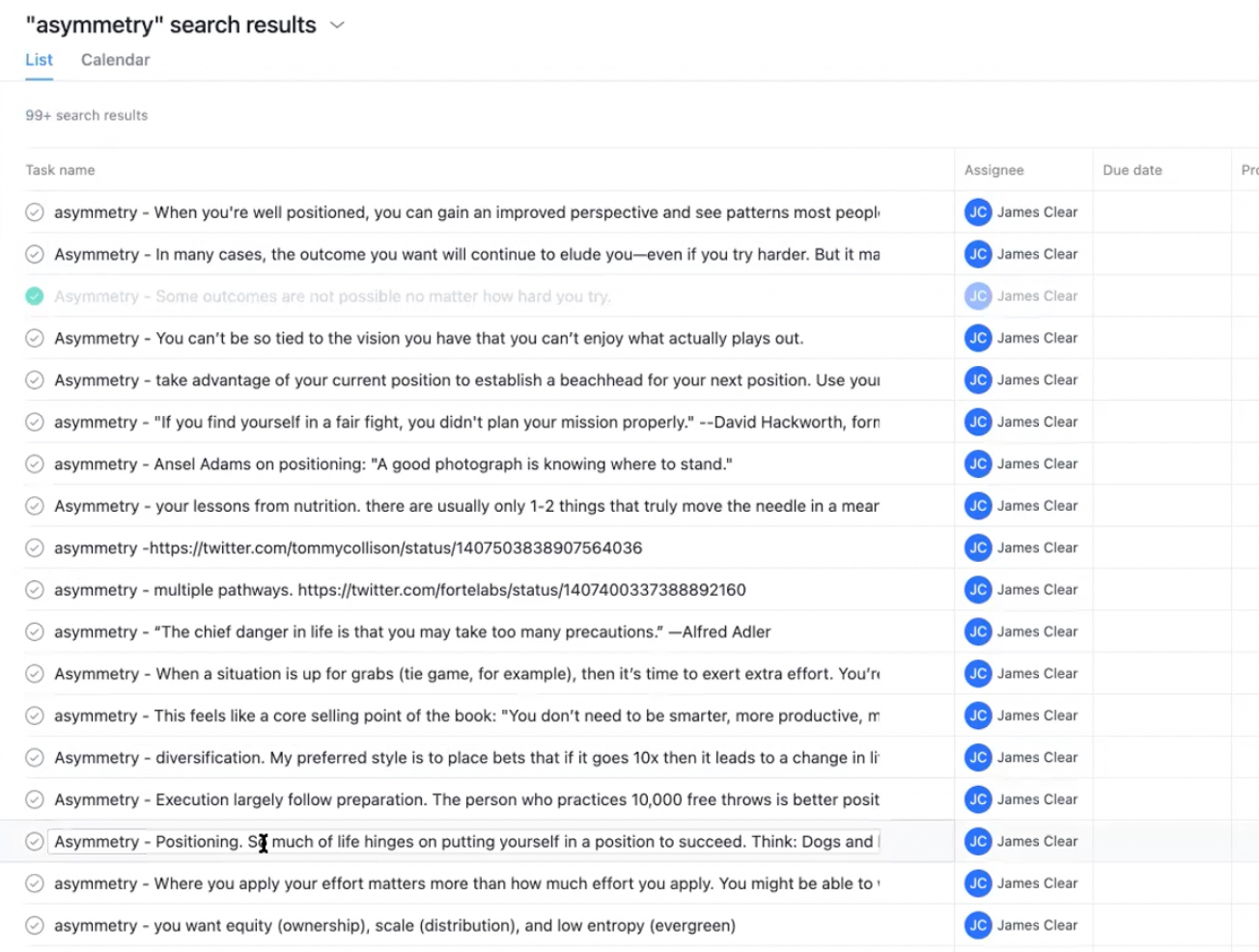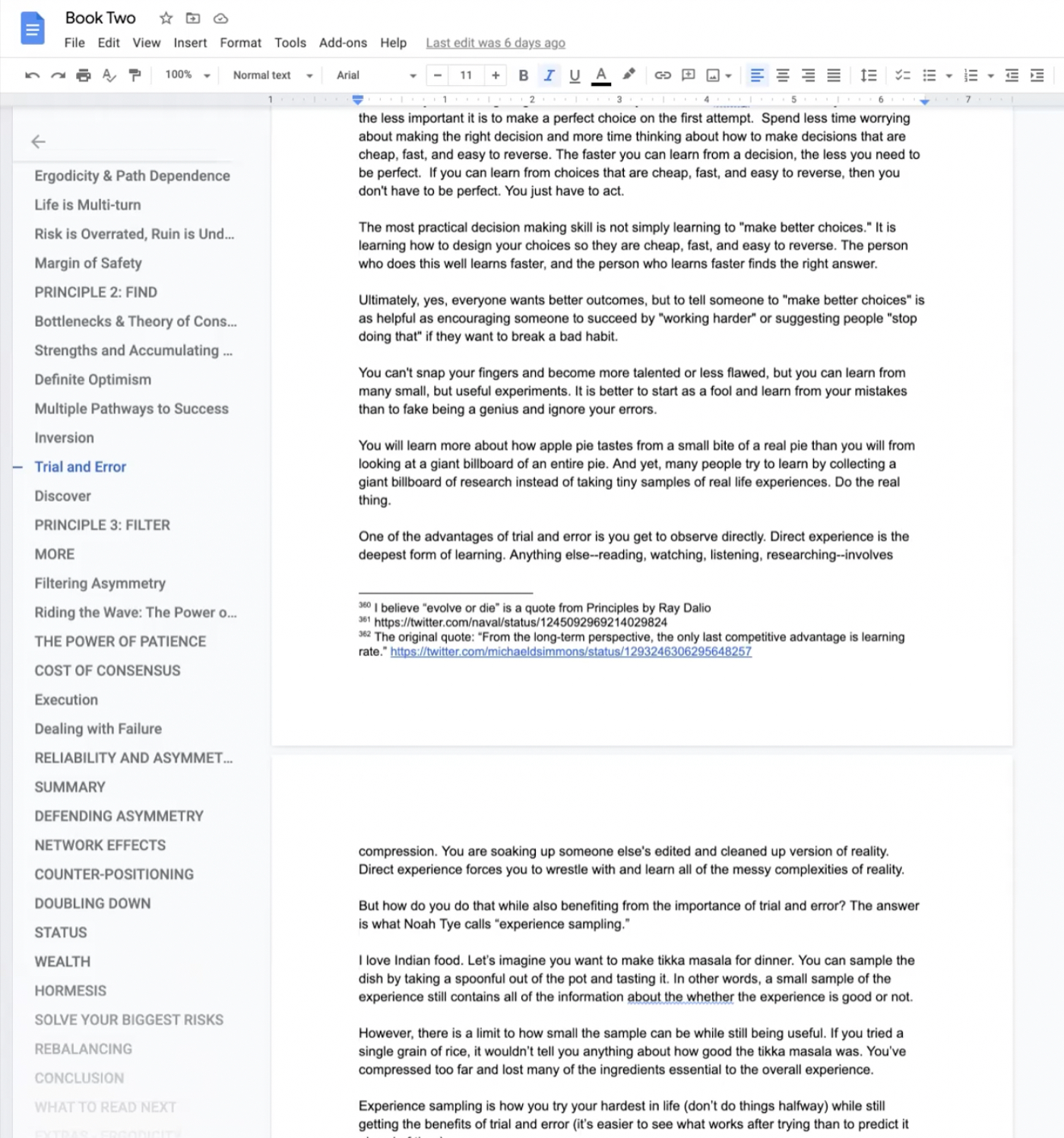James Clear is in the creative muck on his next book. It’s currently a 600 page Google Doc—and he’s trying to compress that down into chapters, sections, and sentences. It’s a big task, but he seems more or less undaunted.
“I think if I was earlier in my career, it would be tougher,” he says. He’s in a black shirt, with a shaved head, spatters of stubble on his face, and blue pooled around his pupils. “I say that, because as you embark on any creative project you explore a lot of dead ends: it's mushy, the vision is pretty foggy, and it doesn't start to crystallize until you keep working on it and iterating and refining and editing.”
This brings up a burning question: how does someone like James break through the creative muck? His last book, Atomic Habits, was a huge best-seller. How is he going about writing a follow-up?
To him, the process is two-fold: both finding what he wants to say, and how to say it so that it will resonate. He has a high-level idea of the book he wants to write, and he’s continually gathering material that relates to it. He collects it into his gigantic Google Doc—and he’s constantly working with it, filling it out and converting it into useful prose.
But as he’s doing this, he’s also running a parallel process: positioning. It’s the most important thing for him at this stage. He wants to know how to package the ideas in his book so that people will pay attention to them. He spends what he calls “unreasonable” amounts of time on this. He uses Twitter as a tool to throw compressed versions of his ideas out into the world to see what sticks. He’s constantly playing with words and sentence structures, trying to figure out what might work as a chapter title or a section heading.
In short, his process is all about figuring out where his readers currently are—what resonates with them, what they care about—and bringing them where he wants them to go.
In this interview, I talk to James about his process for the book, how he thinks about positioning, how he uses Asana, Google Docs, and Evernote, and how he keeps perspective as he works on his next project.
Let’s dive in!
These are James’ answers as told to Dan Shipper, summarized, condensed, and edited for length and clarity.
Get access to the best feature writing in tech—including 60+ productivity interviews, explainers on strategy and finance, and breakdowns of internet culture when you join Every.
James introduces himself
I'm an author and an entrepreneur, probably best known for writing Atomic Habits—a book about habits, behavior change, and continuous improvement.
The other major projects that I work on are at jamesclear.com, and they include 3-2-1, my weekly newsletter, which has over a million subscribers. I also do keynote speeches, and work with businesses on building better habits and improving performance.
Let me take one step back before we get into this. One thing that I want to make clear is that, I as I talk about my process, this is just how it is right now for me. It’s not how it’s always been, or how it will continue to be. I think that it’s really important that people understand that none of this is set in stone.
How I’m writing my next book
From a high level, I'm just trying to show up every day and do the work.
But more specifically, a lot of the work early on in a book is about positioning. Positioning the product, packaging the ideas, figuring out the right frame, so that it's something that people will be interested in.
Different people write for different reasons, but in my personal opinion, the only reason that you would put ideas into book format is because you want to reach people. When you write for yourself, it's called a journal, but when you write for other people it's called a book.
And so if part of your objective is to spread ideas, and to help others, and to do that as widely as possible, then if you’re writing a book you need to ask a series of questions that are related to: How do I reach people? What do people want to read? What kind of books will they open?
You can, and should, still write about what you want to write about. But the idea is to learn to frame what you want to write about in a way that people will be interested in.
So what I’m mostly focused on right now for this book is positioning it. Here’s how I think about it.
Positioning is starting where the reader is, and bringing them to where you want them to go
I’m not smart enough to come up with a really good idea right away, in the first hour of day one. I need to sit with ideas for a long time.
I will spend what might seem to others like an unreasonable amount of time doing this. A lot of people might be like, ‘OK, we worked on positioning for a week—let’s move on and start executing!’ But I will sit with it for six months, or a year—however long it takes for the idea to feel like it’s fully formed.
Here’s why giving this process time works so well: you know how if you’re playing a game of I Spy, and someone says, ‘I spy the blue thing’—it seems like every blue thing in the room instantly starts to light up to you?
When you have a big concept in the back of your mind, it becomes a filter that everything you experience runs through. Now, you’re not simply having experiences throughout the year—you’re having a whole year’s worth of experiences that all get related to the concepts you’re thinking about and working on.
That really helps not just with the details, and with fleshing out chapters. It also helps you see how the idea interfaces with everyday life. You start to see the connections between the idea you want to write about and the world around you.
And that puts you in a better position to figure out what the positioning of the book should be.
This is the reverse of how most people write. Most people start with something they want to say or a point they want to make, and try to move from that point to the reader.
I think it’s actually better to work the other way—to ask what people already desire. Then move backwards from there to that point you wanted to make. If you do that, you don’t have to fight an uphill battle.
I’ll give you an example. Atomic Habits has a chapter where I talk about deliberate practice. Now, it could have been a whole book about deliberate practice, in which I talked about habits. Instead, it was a book about habits where I talked about deliberate practice. I think the difference between how those two books would sell is enormous.
I don’t need to convince you that habits play an important role in life—just by virtue of growing up in society you know that having good habits is favorable, and having bad habits is unfavorable.
On the other hand, ‘deliberate practice’ is a term that takes at least thirty seconds to unpack—and you don’t get thirty seconds. If somebody is just browsing and comes across your book, chances are they have no idea who you are, and you’re not going to be there in person to explain ‘deliberate practice’. You’ve already lost them.
You don’t want to have to convince people that they should care about your idea. It’s much better to be convincing them that you have the best book or product on an idea they already care about.
I don’t know how to fast-forward this process. You just need time.
Positioning helps me compress my work into a simple idea
The second thing you need for packaging and positioning an idea is to compress the high-quality work you’re doing into a good, simple tagline or subtitle. You want something that word of mouth can latch onto and help drive.
Here’s an example: people listen to the Freakonomics podcast because they produce interesting, high-quality episodes about business and surprising elements of economics. But how do you compress a forty-five-minute podcast into something that can be shared easily in conversation?
Well, they have a really good tagline: ‘the hidden side of everything’. It compresses that forty-five minutes into one little sentence. And they compress that even further: the very word ‘Freakonomics’ has become shorthand for ‘the hidden side of everything’.
‘Freakonomics’ is a made-up word. They can own it, and it can occupy an independent position in the listener’s or reader’s mind that doesn’t compete with anything else.
Another way to do that is to take the topic you’re writing about and pair it with an unexpected word. ‘Deep Work’, ‘Extreme Ownership’, or ‘Atomic Habits’ are all good examples of that. What’s my book about? It’s about habits, but ‘Atomic Habits’ is a weird phrase that people only started to say when the book came out, so I own that phrase in people’s minds.
I use Asana as a dumping ground for ideas.
Ideas I’m working on and anything relevant I come across all get dumped into Asana on my desktop. Asana is a fast way for me to capture an idea—I can get it down and come back to it later.
I collect as much as I can here, and I use it to play with a bunch of different ideas in all sorts of ways. For instance, down on the right is an example of me brainstorming for podcast titles around words like ‘hindsight’, ‘timeless’, and ‘timely’:
I write in whatever comes to mind—a possible title, or a possible tagline. Here, I’m just playing with words. I was thinking that the words ‘hidden’ and ‘easy’ are kind of interesting:
I’ve been using the word ‘Asymmetry’ as a sort of catch-all project name for my next book, and a category for any ideas related to it. Whenever an idea comes up for the book, I’ll write ‘Asymmetry’ and a dash, then the idea or post or quote. So this becomes a holding ground for all those ideas.
For example, I was having a conversation with a friend, and got this idea about positioning. I wrote it out, threw it in here, and labeled it ‘asymmetry’:
Eventually, I get a bunch of stuff in here, and each week or so, I’ll go back through Asana and paste all those ideas into an ever-growing Google Doc. That’s where I’ll collect, filter, and sort all the content for my book.
I write and edit my books in Google Docs.
At the beginning of a book project, all the ideas get pasted in from Asana, in no particular order. Eventually, though, that Doc will get to be pretty long—right now, I think it's up to 600 pages or so! But long before it gets that long, I’ll carve out an afternoon to go through everything in there and start grouping ideas that are related. The whole book starts to take shape like that.
I was working on some filtering of the document recently:
I have a bunch of ideas grouped under the heading ‘Trial and Error’. Last week, I started to go through that heading, and it was a total mess, so I started sorting things into subtopics. There were a variety of things related to experimenting fast, so I made a ‘Go Fast’ subtopic, and put all those ideas in there.
And then I had to make another section, about ‘Going All In’, for a bunch of paragraphs and quotes related to that idea:
So you can see that I have some successive filtering starting to take shape. It doesn't look organized to begin with, but the order finds itself as time goes on.
The inefficient part of my process is that it takes a long time to organize all these ideas. I can easily see how most people would not have the patience for it—even for me, it sometimes feels like a slog. The bottom line is that it takes a while to go through—it’s a giant pain to edit something that’s this big. It just requires a lot of patience, persistence, and delayed gratification!
Some techniques I use for compressing ideas
I'm always working on compression—on creating the most potent form of an idea in the fewest words possible.
I have a couple of different strategies for doing that, and one of them involves taking the structure of great sentences that already exists and using it as the bones for a new sentence.
Here’s a good example: a key point in the first chapter of Atomic Habits is, ‘You don't rise to the level of your goals, you fall to the level of your systems’.
That’s actually a play off of a quote from the Greek philosopher Archilochus—‘We don’t rise to the level of our expectations, we fall to the level of our training.’ I just took the rough structure of what he said, and played around with plugging words into it to see how I could make it fit with what I was trying to write.
Another example of this comes from a sentence written by the computer scientist Claude Shannon, who said, ‘Information is the resolution of uncertainty.’ I thought that was interesting—and then I started to wonder if I could take his sentence structure and turn it into something else.
I just removed his words, and left the framework, ‘Blank is the blank of blank.’ I played with a bunch of variants until I eventually came up with ‘Writing is the antidote to confusion.’ I tweeted that out and it went over well.
My other strategy is simply based on hard work and the law of large numbers. There is a pithy and potent sentence that appears in Chapter Two of the book: ’Every action you take is a vote for the type of person you wish to become’.
That line came up while I was writing a lot about habits and identity, and I eventually came up with a good way to express my ideas. The point is that if you write a lot of sentences, occasionally you’ll come up with a good one—persistence pays off!
Twitter is an amazing tool to help develop my ability to do compression. I try to send one tweet per day, and that forces me to compress an idea down and get it tight. I’ve arrived at a lot of the titles and subheadings I’ve used like that.
I'm addicted to browser tabs
I’m addicted to having a bunch of tabs open in my browser. Someone referred to it as ‘tab debt’—and I obviously have a lot of tab debt!
I feel like it’s fine, though: I’m interested in a lot of things, so whenever I find something interesting, I just open it up in a tab.
My first few tabs are all pinned—Asana, which I use to communicate with my team and to categorize ideas; Gmail; my meal plan and nutrition program; and I save a lot of stuff in OneTab too:
I think of the rest of my open tabs as a reading list that I sometimes get to. I bet I’ll read at least 30% of the tabs I have open over any two-week period. If I don’t get around to reading a particular tab, then it must mean it’s not really that important to me—but at least I gave it a chance!
I keep notes on what I read in Evernote.
I read in all three formats—print, digital, and audio. But if my specific intention is to utilize some of the ideas from whatever I’m reading, I prefer print. When I read, I put brackets around the sections I like, and mark them with an asterisk.
When I’m through with that book, I’ll box it up along with any others I’ve read in that way, and send it to my assistant. She’ll transcribe all those sections and put them into Evernote.
I do the same thing with articles I read online. My main Notebook in Evernote is called ‘Articles’, and it currently has 991 notes in it. Almost all of them are article ideas, which makes a big backlog of stuff I can refer to whenever I want to work on something.
Here’s a good example of a quote I liked, about the Japanese concept of kintsugi—the idea of celebrating imperfections and using that to your advantage. I just threw it into Evernote, linked to the source, and moved on. I’ll have another go at it later.
Most of the time, the text I save in Evernote will be relevant to something I’m working on for a book. It might be a quote that’s relevant to a certain topic, or an idea that I want to expand upon, which will become a writing prompt for me. Anything that feels like it might be a good fit for, say, 3-2-1, will go into a separate list for future newsletters.
How I keep perspective while working on my next book
When my first book sold really well and got lots of attention, I oscillated between lots of different emotions. I felt everything from excitement, to pride in how hard I worked, to self-doubt—why this book, and not all the other great ones out there?
But in general, I think I stayed in a fairly balanced and reasonable place: Atomic Habits was a thing that I worked on, it helped a lot of people, and it fulfilled its purpose.
But after all of that, I still need to wake up every day, be a good person, and work on the same things that I was working on before. And if I want to continue to be a writer, I need to keep writing—that identity starts to expire if you don’t use it.
I can imagine a version of my life where working on my next book is paralyzing. I’ve watched really closely as some friends who’ve had stuff that’s really taken off for them go through that paralysis to varying degrees.
But I don’t want to be the adult version of the kid who peaked in high school, or the person who had a hit, and is still talking about it ten years later. Now is the time to move on to the next thing and try to do a good job with it.
There’s more of life to live!
Want more like this?
Get access to the best feature writing in tech—including 60+ productivity interviews, explainers on strategy and finance, and breakdowns of internet culture when you join Every.









